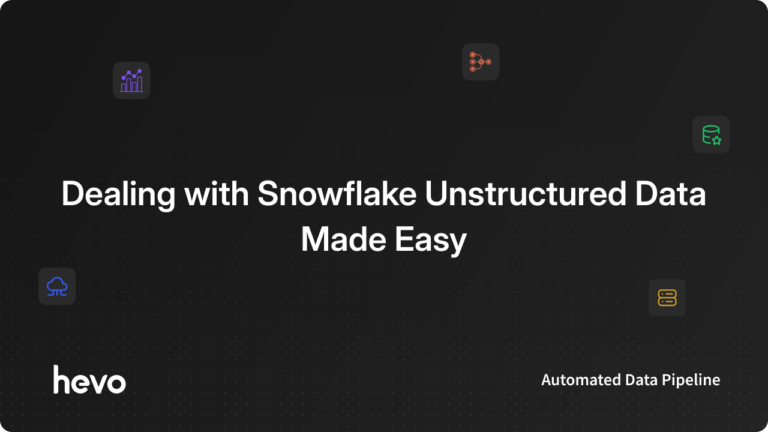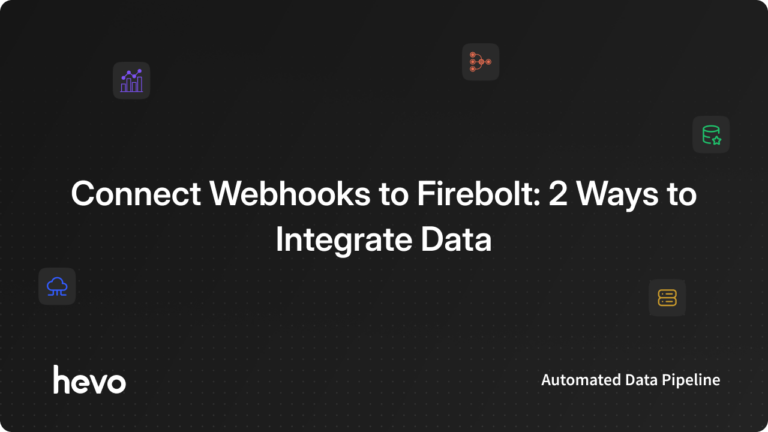Easily move your data from Webhook To Snowflake to enhance your analytics capabilities. With Hevo’s intuitive pipeline setup, data flows in real-time—check out our 1-minute demo below to see the seamless integration in action!
Automation of data management captures and transfers large datasets across platforms quickly. Webhooks are more streamlined for workflow automation because they connect applications in near real-time, transferring data whenever specific events happen.
Snowflake scales things up in managing complex, high-concurrency events and allows independent task handling to prevent delays. Integrate your Webhook with Snowflake to increase the efficiency of managing and analyzing your incoming data significantly.
This article will explore how to transfer data from Webhook to Snowflake using two different methods.
Table of Contents
Overview of webhooks
A webhook is a service that lets data transfer from one application to the other in real time. This simply means it passes on information or data on actions taken in one application while an event occurs directly as soon as the other system can receive it.
Key Features of webhooks:
- Real-time data transfer: It automatically sends the data every time an event occurs so that information becomes available in real-time.
- Event-driven: Taking action in accordance with the events based on a set of applications, and that is thus sustainable through automation and efficiency.
- Pre-configured task execution: Triggers automated task execution because of the data received through automation.
Overview of Snowflake
Snowflake is a cloud data platform used for warehousing and analytics. It is scalable and effective when dealing with large volumes.
Key features of Snowflake
- Massively Parallel Processing (MPP): Snowflake utilizes cluster nodes, where each node processes a section of data and hence executes queries much faster and more efficiently.
- Cloud Native Architecture: It utilizes the new SQL query engine designed solely for cloud computing for better performance as well as scalability.
- Complete Data Management: All information, including storage and organization, compression, and statistics, is handled by the applications.
Solve your data replication problems with Hevo’s reliable, no-code, automated pipelines with 150+ connectors(60+ Free).
Check out other features that Hevo provides:
- Experience real-time data integration without coding.
- Achieve error-free data through automatic schema mapping.
- Build complex workflows with a drag-and-drop feature.
See why Hevo has 4.3 rating on G2 and industry leaders like Zippi prefer Hevo to improve the data quality for data-driven risk assessment.
Get Started with Hevo for FreeWhy Integrate Webhook to Snowflake?
There are several advantages to loading data from Webhook to Snowflake. Let us look at some of them:
- Scalability: Snowflake offers scalability. It accommodates a large amount of data generated from Webhook without any difficulty. Scalability allows you to handle heavy workloads efficiently without compromising performance.
- Data Processing in Concurrent Environment: Snowflake virtual data warehouse allows you to store incoming customer data by separating the computing resources from storage resources. The data from Webhooks can include website visits, product purchases, engagement metrics, and more, which can be automatically managed and allocated using Snowflake’s multi-cluster warehouse.
- Real-time Analysis of Customer Data: Snowflake supports real-time data analysis. It allows immediate insights into customer behavior, buying preferences, and more. These insights help you make predictions and personalize marketing campaigns to target the right customers.
A Snowflake-native app to monitor Fivetran costs
Method 1: Data Integration from Webhook to Snowflake Using Hevo
Prerequisites
- For Webhooks:
- You must be assigned the role of Team Administrator, Team Collaborator, or Pipeline Administrator to create a Hevo pipeline.
- For Snowflake:
- You must have an active Snowflake account.
- Create and configure the Snowflake warehouse.
- Obtain your Snowflake account URL.
- If you create a warehouse, the user should have the role of ACCOUNTADMIN OR SYSADMIN.
- Hevo must be assigned permission to use USAGE and CREATE SCHEMA for the data warehouse and database.
- Hevo must be assigned permissions for USAGE, CREATE TABLE, CREATE EXTERNAL TABLE, MODIFY, and MONITOR for the current and future schema.
Step 1: Configure Webhook as Your Source
- Step 1.1: In the Navigation Bar, Click PIPELINES.
- Step 1.2: Click + CREATE in the Pipelines List View.
- Step 1.3: Select Webhook as your source on the Select Source Type page.
- Step 1.4: Specify the mandatory fields to build a connection on the Configure your Webhook Source Settings page.
Step 2: Configure Snowflake as Your Destination
- Step 2.1: Select DESTINATIONS from the Navigation Bar.
- Step 2.2: Click on +CREATE in the Destination View Lists.
- Step 2.3: Select Snowflake as your destination on the Add Destination Page.
- Step 2.4: On the Configure your Snowflake Destination Settings page, specify the following details:
Method 2: Integrating Data from Webhook to Snowflake Using CSV File
Prerequisites
- Create a Snowflake account with the necessary privileges to create databases, tables, and objects.
- Install SnowSQL.
Step 1: Export Webhook Data as a CSV File
- Open the Webhook website and click on the CSV Export option. Once you click on this option, all your data will be downloaded in CSV file format on your local system.
Note: You can also download files to your local system or workstation using Webhook.site CLI.
Step 2: Import the CSV File to Snowflake
- Step 2.1: Run the
CREATE FILE FORMATcommand to create a ‘mycsvformat’ file format.
CREATE OR REPLACE FILE FORMAT mycsvformat
TYPE = 'CSV'
FIELD_DELIMITER = '|'
SKIP_HEADER = 1;
- Step 2.2: Execute the CREATE STAGE command to create a ‘my_csv_stage’ stage.
CREATE OR REPLACE STAGE my_csv_stage
FILE_FORMAT = mycsvformat;- Step 2.3: You must use the PUT command to upload your sample data files from the local system to the stage you created earlier.
- For Linux or macOS
PUT file:///tmp/load/contacts*.csv @my_csv_stage AUTO_COMPRESS=TRUE;- For Windows
PUT file://C:\temp\load\contacts*.csv @my_csv_stage AUTO_COMPRESS=TRUE;- Step 2.4: Execute the COPY INTO<table> to load the staged data to the target table. This example uses contact information uploaded to Snowflake.
COPY INTO mycsvtable
FROM @my_csv_stage/file1.csv.gz
FILE_FORMAT = (FORMAT_NAME = mycsvformat)
ON_ERROR = 'skip_file';
NOTE: After copying data to the target tables, you must remove copied data files from the intimidatory staged table using the Remove command.
Limitations for Integrating Data from Webhook to Snowflake Using CSV File
- Each time you implement the exporting process to extract data from Webhook, you have to do it manually, which makes the process cumbersome.
- You must have the necessary permissions to execute the COPY command in Snowflake; otherwise, you may face restrictions preventing you from importing the data.
- The COPY command may sometimes skip files while loading the staged CSV file into the Snowflake table, which could cause data loss and inconsistencies.
Why Integrate Webhooks to Snowflake?
There are several advantages of loading data from Webhooks to Snowflake:
- Scalability: Snowflake offers scalability that accommodates a large amount of data generated from Webhooks without any difficulty. Scalability allows you to handle heavy workloads efficiently without compromising performance.
- Data Processing in Concurrent Environment: The data from webhooks can include website visits, product purchases, engagement metrics, and more, which can be automatically managed and allocated using Snowflake’s multi-cluster warehouse.
- Real-time Analysis of Customer Data: Snowflake supports real-time data analysis. It allows immediate insights into customer behavior, buying preferences, and more. These insights help you make predictions and personalize marketing campaigns to target the right customers.
Conclusion
Integrating your Webhook data into the Snowflake warehouse allows you to organize it efficiently and get a comprehensive view of customer activities on various channels. This integration can help you make sound decisions regarding business activities to achieve your objectives.
You can use CSV files for data integration between the two platforms, but opting for this method can make data scalability difficult. Hevo helps you transfer large amounts of data from source to destination using its no-code, automated data pipeline, making your work easy.
FAQs (Frequently Asked Questions)
Q. Can we send alert notifications to web service Webhook API from Snowflake?
Snowflake doesn’t have an in-built function to send direct alert notifications to Webhook or external API. However, you can call an external function “in it” on top of API integration to send data to your web service API.
Q. Does Snowflake support Webhooks?
Snowflake does not natively support webhooks, but you can include notifications when using outside systems like Slack, MS Teams, etc.
Q. Can Snowflake connect to API?
Yes, Snowflake supports connectivity through APIs with external functions or using tools like Snowpipe, which accepts data ingestion from APIs and third-party ETL tools for general-purpose integration.









